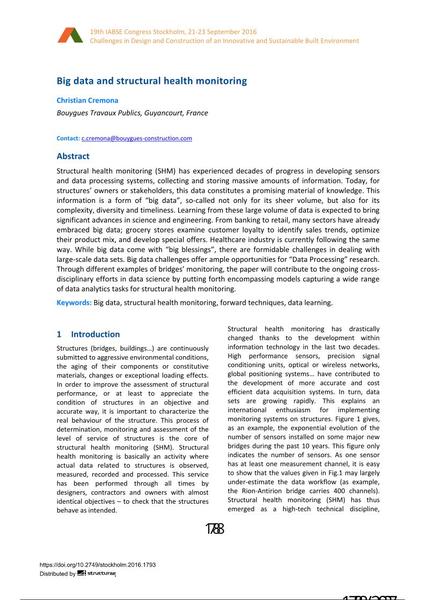Big data and structural health monitoring

|
|
|||||||||||
Détails bibliographiques
| Auteur(s): |
Christian Crémona
(Bouygues Travaux Publics, Guyancourt, France)
|
||||
|---|---|---|---|---|---|
| Médium: | papier de conférence | ||||
| Langue(s): | anglais | ||||
| Conférence: | IABSE Congress: Challenges in Design and Construction of an Innovative and Sustainable Built Environment, Stockholm, Sweden, 21-23 September 2016 | ||||
| Publié dans: | IABSE Congress Stockholm, 2016 | ||||
|
|||||
| Page(s): | 1788-1796 | ||||
| Nombre total de pages (du PDF): | 9 | ||||
| Année: | 2016 | ||||
| DOI: | 10.2749/stockholm.2016.1793 | ||||
| Abstrait: |
Structural health monitoring (SHM) has experienced decades of progress in developing sensors and data processing systems, collecting and storing massive amounts of information. Today, for structures’ owners or stakeholders, this data constitutes a promising material of knowledge. This information is a form of “big data”, so-called not only for its sheer volume, but also for its complexity, diversity and timeliness. Learning from these large volume of data is expected to bring significant advances in science and engineering. From banking to retail, many sectors have already embraced big data; grocery stores examine customer loyalty to identify sales trends, optimize their product mix, and develop special offers. Healthcare industry is currently following the same way. While big data come with “big blessings”, there are formidable challenges in dealing with large-scale data sets. Big data challenges offer ample opportunities for “Data Processing” research. Through different examples of bridges’ monitoring, the paper will contribute to the ongoing cross- disciplinary efforts in data science by putting forth encompassing models capturing a wide range of data analytics tasks for structural health monitoring. |
||||
